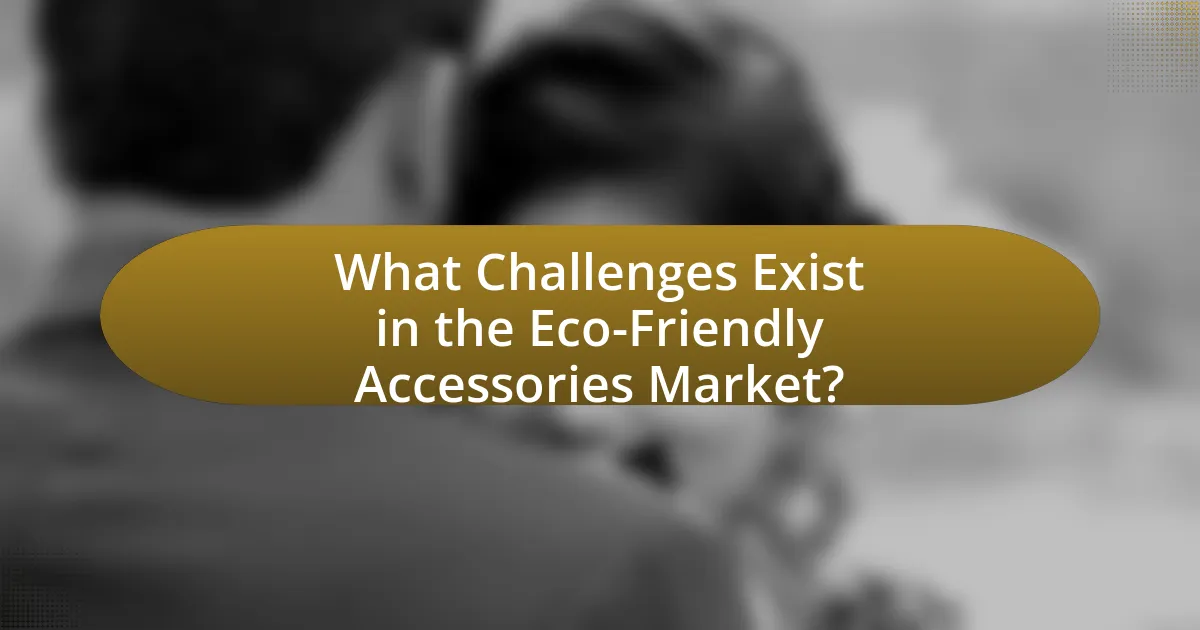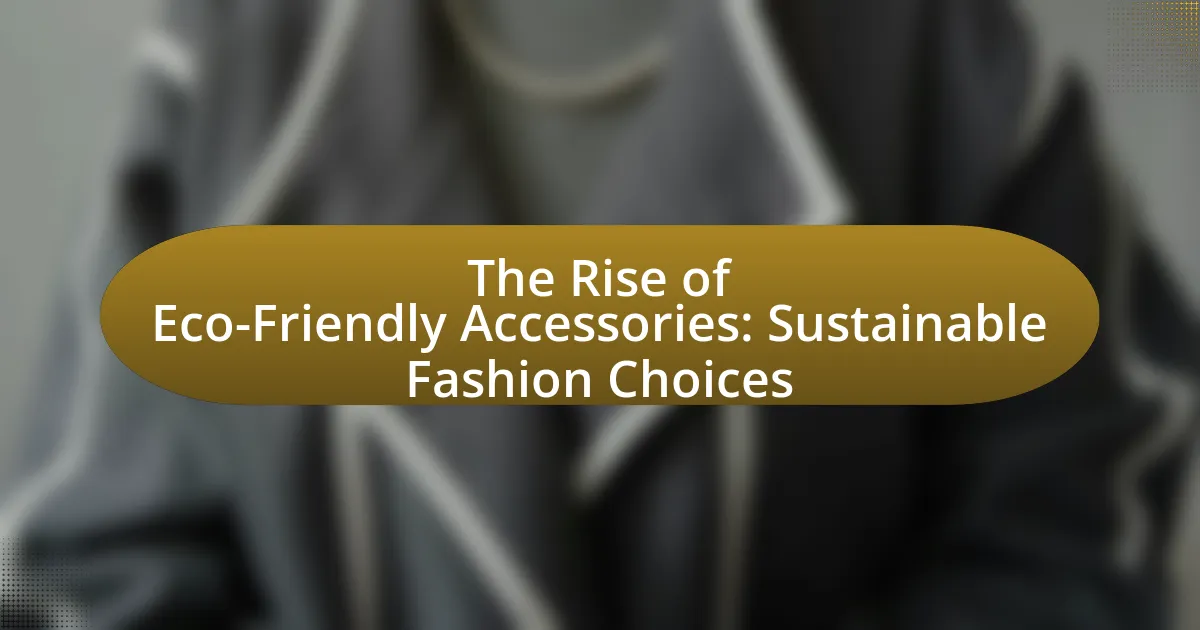Eco-friendly accessories represent a significant trend in sustainable fashion, focusing on minimizing environmental impact through the use of sustainable materials and ethical production practices. These accessories, made from organic, recycled, or biodegradable materials, differ from traditional fashion items by prioritizing sustainability and ethical labor conditions. The article explores the materials commonly used in eco-friendly accessories, the impact of production processes on sustainability, and the increasing consumer demand driven by heightened awareness of environmental issues. Additionally, it addresses the benefits of choosing eco-friendly accessories, the challenges faced by brands in this market, and practical tips for consumers to incorporate sustainable choices into their wardrobes.

What are Eco-Friendly Accessories in Sustainable Fashion?
Eco-friendly accessories in sustainable fashion are items designed to minimize environmental impact through the use of sustainable materials and ethical production practices. These accessories often include products made from organic, recycled, or biodegradable materials, such as bags crafted from recycled plastics, jewelry made from sustainably sourced metals, and footwear produced using eco-friendly processes. The rise of eco-friendly accessories is supported by a growing consumer demand for sustainable options, with a report from McKinsey & Company indicating that 67% of consumers consider sustainability when making a purchase.
How do Eco-Friendly Accessories differ from traditional fashion items?
Eco-friendly accessories differ from traditional fashion items primarily in their materials and production processes. Eco-friendly accessories are made from sustainable, biodegradable, or recycled materials, such as organic cotton, hemp, or recycled plastics, which minimize environmental impact. In contrast, traditional fashion items often utilize synthetic materials like polyester and nylon, which are derived from petroleum and contribute to pollution and waste. Additionally, eco-friendly accessories typically emphasize ethical production practices, ensuring fair labor conditions and reduced carbon footprints, whereas traditional items may not prioritize these factors. This distinction is supported by the growing consumer demand for sustainable products, with a report from McKinsey & Company indicating that 67% of consumers consider sustainability when making a purchase.
What materials are commonly used in Eco-Friendly Accessories?
Eco-friendly accessories are commonly made from materials such as organic cotton, bamboo, recycled plastics, cork, and hemp. Organic cotton is cultivated without harmful pesticides, making it a sustainable choice. Bamboo grows rapidly and requires minimal resources, while recycled plastics help reduce waste by repurposing materials that would otherwise contribute to pollution. Cork, harvested from the bark of cork oak trees, is renewable and biodegradable. Hemp is a durable fiber that grows quickly and requires little water, making it an environmentally friendly option. These materials collectively contribute to reducing the environmental impact of fashion accessories.
How do production processes impact the sustainability of these accessories?
Production processes significantly impact the sustainability of eco-friendly accessories by determining resource efficiency, waste generation, and environmental footprint. For instance, sustainable production methods, such as using organic materials and renewable energy, reduce reliance on non-renewable resources and lower greenhouse gas emissions. According to a study by the Ellen MacArthur Foundation, transitioning to circular production models can decrease waste by up to 80% in the fashion industry. Additionally, ethical labor practices in production processes ensure that social sustainability is maintained, contributing to the overall sustainability of the accessories.
Why is the demand for Eco-Friendly Accessories increasing?
The demand for eco-friendly accessories is increasing due to heightened consumer awareness of environmental issues and a growing preference for sustainable products. Studies indicate that 66% of global consumers are willing to pay more for sustainable brands, reflecting a shift in purchasing behavior towards environmentally responsible choices. This trend is further supported by the rise of social media, which amplifies the visibility of eco-conscious brands and influences consumer preferences. Additionally, the fashion industry’s significant contribution to pollution and waste has prompted consumers to seek alternatives that align with their values, driving the demand for eco-friendly accessories.
What role does consumer awareness play in this trend?
Consumer awareness significantly drives the trend of eco-friendly accessories in sustainable fashion. As consumers become more informed about environmental issues and the impact of their purchasing decisions, they increasingly seek products that align with their values, such as sustainability and ethical production. A 2021 survey by McKinsey & Company found that 67% of consumers consider sustainability when making a purchase, indicating a strong correlation between awareness and consumer behavior. This heightened awareness compels brands to adopt eco-friendly practices and innovate in their product offerings to meet the demand for sustainable options.
How do environmental concerns influence purchasing decisions?
Environmental concerns significantly influence purchasing decisions by prompting consumers to favor eco-friendly products over conventional options. Research indicates that 66% of global consumers are willing to pay more for sustainable brands, reflecting a growing awareness of environmental issues. This shift is driven by factors such as the desire to reduce carbon footprints, support ethical practices, and contribute to sustainability efforts. Additionally, brands that prioritize environmental responsibility often experience increased customer loyalty and positive brand perception, further reinforcing the impact of environmental concerns on consumer behavior.

What are the Benefits of Choosing Eco-Friendly Accessories?
Choosing eco-friendly accessories reduces environmental impact by minimizing waste and pollution associated with traditional manufacturing processes. These accessories are often made from sustainable materials, such as organic cotton, recycled plastics, or biodegradable substances, which contribute to lower carbon footprints. For instance, a study by the Ellen MacArthur Foundation highlights that switching to sustainable materials can reduce greenhouse gas emissions by up to 70% in the fashion industry. Additionally, eco-friendly accessories often promote ethical labor practices, ensuring fair wages and safe working conditions for artisans and workers. This combination of environmental and social benefits makes eco-friendly accessories a responsible choice for consumers.
How do Eco-Friendly Accessories contribute to environmental sustainability?
Eco-friendly accessories contribute to environmental sustainability by reducing waste and minimizing the use of harmful materials. These accessories are often made from sustainable resources, such as organic cotton, recycled plastics, or biodegradable materials, which help decrease the carbon footprint associated with production. For instance, a study by the Ellen MacArthur Foundation highlights that using recycled materials can significantly lower greenhouse gas emissions compared to virgin materials. Additionally, eco-friendly accessories promote a circular economy by encouraging recycling and upcycling, which further reduces landfill waste. This shift in consumer behavior towards sustainable products fosters a more responsible approach to fashion, ultimately benefiting the environment.
What are the long-term benefits of using sustainable materials?
The long-term benefits of using sustainable materials include reduced environmental impact, enhanced resource efficiency, and improved economic viability. Sustainable materials, such as organic cotton and recycled plastics, minimize pollution and waste, contributing to a healthier ecosystem. For instance, the use of organic cotton reduces water consumption by up to 91% compared to conventional cotton farming, as reported by the Textile Exchange. Additionally, sustainable materials often lead to lower energy consumption during production, which can decrease greenhouse gas emissions significantly. Economically, businesses that adopt sustainable practices can benefit from increased consumer demand, as 66% of global consumers are willing to pay more for sustainable brands, according to Nielsen. This shift not only fosters brand loyalty but also encourages innovation in product development, ensuring long-term viability in a competitive market.
How do these accessories support ethical labor practices?
Eco-friendly accessories support ethical labor practices by ensuring fair wages and safe working conditions for artisans and workers involved in their production. Many brands prioritize partnerships with certified fair trade organizations, which enforce labor standards that prohibit child labor and promote equitable pay. For instance, the World Fair Organization reports that fair trade practices can increase artisans’ income by 20-50%, directly benefiting their communities. Additionally, eco-friendly accessories often utilize sustainable materials sourced from suppliers who adhere to ethical labor practices, further reinforcing the commitment to social responsibility in the fashion industry.
What impact do Eco-Friendly Accessories have on personal style?
Eco-friendly accessories significantly enhance personal style by promoting individuality and ethical expression. These accessories, made from sustainable materials like organic cotton, recycled metals, and biodegradable plastics, allow individuals to showcase their commitment to environmental responsibility while maintaining aesthetic appeal. For instance, a study by the Fashion Institute of Technology found that 66% of consumers are willing to pay more for sustainable fashion, indicating a growing trend where eco-friendly choices are becoming synonymous with style. This shift not only influences consumer purchasing behavior but also encourages designers to innovate, leading to unique and fashionable options that align with personal values.
How can consumers express individuality through sustainable fashion choices?
Consumers can express individuality through sustainable fashion choices by selecting unique, ethically produced items that reflect their personal style and values. This can include choosing handmade accessories, vintage clothing, or brands that prioritize sustainable materials and fair labor practices. For instance, a study by the Global Fashion Agenda highlights that 66% of consumers are willing to pay more for sustainable fashion, indicating a strong desire to align personal identity with eco-conscious choices. By opting for these distinctive pieces, consumers not only showcase their individuality but also contribute to a more sustainable fashion industry.
What trends are emerging in the eco-friendly accessory market?
Emerging trends in the eco-friendly accessory market include the increased use of sustainable materials, such as recycled plastics and organic fabrics, and a growing emphasis on ethical production practices. Brands are increasingly adopting circular economy principles, which focus on reducing waste through recycling and upcycling. For instance, a report by Grand View Research indicates that the global sustainable fashion market is expected to reach $8.25 billion by 2023, highlighting the rising consumer demand for eco-friendly products. Additionally, personalization and customization options are becoming popular, allowing consumers to express their individuality while supporting sustainable practices.

What Challenges Exist in the Eco-Friendly Accessories Market?
The eco-friendly accessories market faces several challenges, including high production costs, limited consumer awareness, and supply chain complexities. High production costs arise from sourcing sustainable materials, which are often more expensive than conventional alternatives. Limited consumer awareness hampers market growth, as many potential buyers are unaware of the benefits of eco-friendly products. Additionally, supply chain complexities can lead to difficulties in maintaining sustainability standards throughout the production process, making it challenging for brands to ensure their products are genuinely eco-friendly. These factors collectively hinder the widespread adoption and success of eco-friendly accessories in the fashion industry.
What barriers do brands face in producing Eco-Friendly Accessories?
Brands face several barriers in producing eco-friendly accessories, primarily including high production costs, limited availability of sustainable materials, and consumer demand challenges. High production costs arise from the need for eco-friendly materials and processes, which can be more expensive than conventional options. Limited availability of sustainable materials restricts brands’ ability to source the necessary components, as many eco-friendly materials are not widely produced or accessible. Additionally, consumer demand challenges occur when customers prioritize price and convenience over sustainability, making it difficult for brands to justify the higher costs associated with eco-friendly products. These barriers collectively hinder the widespread adoption of eco-friendly accessories in the fashion industry.
How does cost affect the accessibility of sustainable fashion items?
Cost significantly limits the accessibility of sustainable fashion items, as higher production expenses often lead to elevated retail prices. Sustainable fashion typically involves ethical sourcing, eco-friendly materials, and fair labor practices, which can increase costs compared to conventional fashion. For instance, a report by the Global Fashion Agenda indicates that sustainable materials can be up to 30% more expensive than their non-sustainable counterparts. Consequently, consumers with limited budgets may find it challenging to purchase these items, resulting in a market skewed towards higher-income individuals. This economic barrier restricts broader adoption of sustainable fashion, hindering its potential impact on environmental and social issues.
What misconceptions exist about Eco-Friendly Accessories?
Misconceptions about eco-friendly accessories include the belief that they are always more expensive, less stylish, and less durable than conventional options. Many consumers assume that sustainable materials inherently lead to higher prices; however, studies show that as demand increases, prices can stabilize or even decrease. Additionally, eco-friendly accessories are often designed with aesthetics in mind, proving that sustainability and style can coexist. Furthermore, the durability of these products is frequently underestimated; many eco-friendly materials, such as recycled plastics and organic cotton, are engineered to be robust and long-lasting, challenging the notion that they are inferior in quality.
How can consumers navigate the Eco-Friendly Accessories market?
Consumers can navigate the Eco-Friendly Accessories market by researching brands that prioritize sustainability and transparency in their production processes. This involves looking for certifications such as Fair Trade, GOTS (Global Organic Textile Standard), or B Corp status, which indicate adherence to ethical and environmental standards. Additionally, consumers should read product labels and reviews to assess the materials used and the brand’s commitment to eco-friendly practices. According to a 2021 report by McKinsey & Company, 67% of consumers consider sustainability when making a purchase, highlighting the growing demand for responsible fashion choices.
What should consumers look for when choosing sustainable accessories?
Consumers should look for materials that are eco-friendly, ethically sourced, and produced with minimal environmental impact when choosing sustainable accessories. Eco-friendly materials include organic cotton, recycled plastics, and biodegradable materials, which reduce waste and pollution. Ethically sourced products ensure fair labor practices and support local communities, contributing to social sustainability. Additionally, consumers should consider the durability and longevity of the accessories, as longer-lasting items reduce the need for frequent replacements, further minimizing environmental impact.
How can consumers verify the sustainability claims of brands?
Consumers can verify the sustainability claims of brands by researching third-party certifications, examining supply chain transparency, and reviewing independent assessments. Third-party certifications, such as Fair Trade, Global Organic Textile Standard (GOTS), and the Forest Stewardship Council (FSC), provide credible validation of a brand’s sustainability practices. Supply chain transparency can be assessed through a brand’s disclosure of sourcing materials and production processes, which is often detailed on their websites or sustainability reports. Independent assessments, such as those conducted by organizations like Greenpeace or the Ethical Consumer, offer evaluations of brands based on their environmental and social impact, further aiding consumers in making informed choices.
What are some practical tips for incorporating Eco-Friendly Accessories into your wardrobe?
Incorporating eco-friendly accessories into your wardrobe can be achieved by selecting items made from sustainable materials, such as organic cotton, recycled metals, or biodegradable fabrics. Prioritize brands that emphasize ethical production practices and transparency in their supply chains, as this ensures that your purchases support environmentally responsible methods. Additionally, consider investing in timeless pieces that can be worn across multiple seasons, reducing the need for frequent replacements. Research indicates that the fashion industry contributes significantly to environmental degradation, with the Ellen MacArthur Foundation reporting that a truckload of textiles is wasted every second. By choosing eco-friendly accessories, you actively participate in reducing this waste and promoting sustainability in fashion.

Leave a Reply